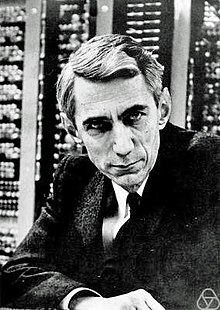Table of Contents

Claude Shannon sits in front of computing equipment.

Claude Shannon sits in front of computing equipment.
The world as we know it has been shaped by many great minds. Inventions that we use everyday, such as your car, your phone, even your toilet, were conceptualized, created, and improved by countless minds over the years to become their current iterations. The internet is no exception. Pioneers like Bob Taylor, John Klensin, Bob Kahn, Vint Cerf, and many others, all contributed to the network of computers we utilize in our everyday lives. This powerful tool, that we use to stream videos, check the weather, and prove our friends wrong, may have never been created without the work done by Claude Shannon.
The son of a businessman turned judge and a high school principal, Claude Shannon, grew up in Gaylord, Michigan. In 1932, he enrolled in the University of Michigan, where he graduated four years later with two bachelor's degrees: one in electrical engineering and one in mathematics. In 1936, he began his graduate studies in electrical engineering at MIT, where he published his Master's thesis, "A Symbolic Analysis of Relay and Switching Circuits" (1937). This paper, in which Shannon proved switching circuits could be used to implement logic, established the underlying concepts used in all digital computers. After receiving his PhD from MIT in 1940, Shannon became a National Research Fellow at the Institute for Advanced Study in Princeton, New Jersey, where he studied across many disciplines and discussed ideas with the likes of Hermann Weyl, John von Neumann, and on occasion, Albert Einstein.
Throughout World War II, Shannon worked for Bell Labs, where he focused his attention on fire-control systems and cryptography. In 1942, he created signal-flow graphs, which are used in the modeling of various cyber-physical systems. In 1945, he coauthored the essay "Data Smoothing and Prediction in Fire-Control Systems" with Ralph Beebe Blackman and Hendrik Wade Bode, which employed data and signal processing in its problem model. Also in 1945, Shannon prepared a classified memorandum titled, "A Mathematical Theory of Cryptography", where he discussed various concepts and mathematical foundations, and stated his desire to "develop these results … in a forthcoming memorandum on the transmission of information."
In 1948, Shannon delivered on his promise in the form of the landmark paper, "A Mathematical Theory of Communication", a two part article in which he discusses the best way to encode information for transmittal. In doing so, Shannon developed the idea of information entropy, the measure of the information content in a message, thereby establishing information theory as a whole. In 1951, Shannon's article, "Prediction and Entropy of Printed English", expanded his ideas in relation to natural language processing and computational linguistics.
Shannon returned to MIT in 1956, where he worked in the Research Laboratory of Electronics until 1978. Later, Shannon devloped Alzheimer's disease and spent his final years in a nursing home. He died in 2001 at the age of 84.
Claude Shannon is regarded as "the father of information theory". His foundational work has impacted the Voyager deep space missions, the inventions of the CD, internet, and mobile phones, and the areas of linguistics, human perception, and black holes. The unit, shannon, more commonly known as a bit, is named after him.
Click here for more information on Claude Shannon.